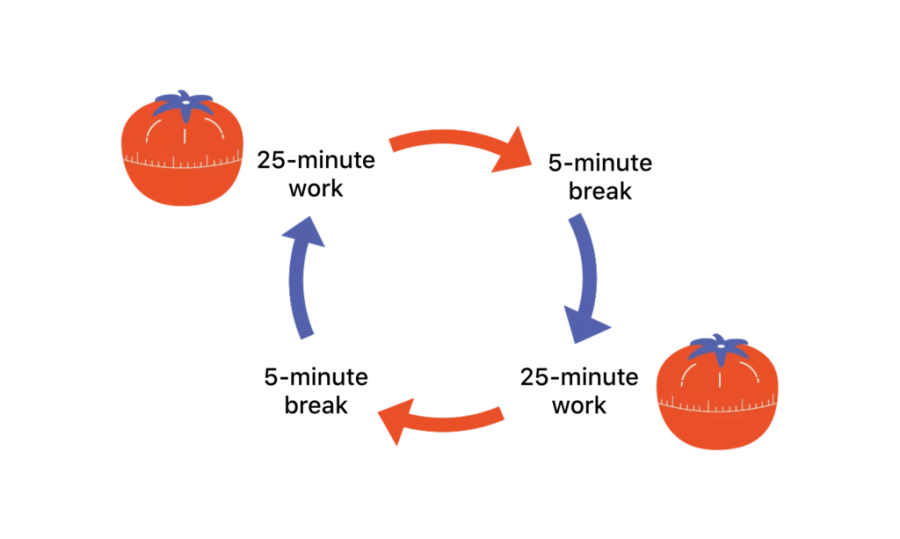Studying With a Purpose: The Pomodoro Technique
March 1, 2023
Throughout my middle school years into the beginning of high school, I have frequently fallen victim to procrastination. I became very comfortable with cramming for tests the night before and completing assignments minutes before the due date.
When I got to high school, I inevitably struggled to combat the new workload. After years of procrastination and bad studying habits, I was unable to complete tasks in an efficient and effective manner.
My experience
It wasn’t until sophomore year in my AP Seminar class where I was introduced to a method that would transform the way I study: the Pomodoro technique.
The Pomodoro Technique is meant to maximize brain productivity by focusing one’s attention on a task for 25 minute intervals. Each interval is separated by a five minute break, allowing the mind to reset before coming back to the task at hand.
My AP Seminar teacher, Mrs. Laura Flangel, introduced this technique to the class while writing our first research paper. Planning, researching, and writing this paper consisted of 10+ separate, tedious steps. Procrastination was simply not an option.
Knowing that she had a class full of students who were used to completing entire assignments the night before, Flangel knew she had to change something in order for her class to produce meaningful work.
“Focus is hard to find in the 21st century – culture is driving everyone to multitask all the time leading to real concentration issues,” said Flangel.
To help keep our class on track, Flangel projected a stopwatch on the front of the room, suggesting that if we were able to focus without distractions for just 25 minutes, we would receive a five minute break.
Undoubtedly, the first few sessions of Pomodoro were difficult. Forcing myself to be in a state of hyper-focus after years of poor studying habits was a major change. I found myself restless at around the 15 minute mark – my mind running and my leg bouncing as I tried to direct all my focus to the essay in front of me.
“It takes time to develop grit,” said Flangel. “But with a little persistence, students get really good at disciplining themselves, especially those who really buy-in and commit to the technique.”
The results
After getting over this initial phase of struggle, I was eventually able to keep my focus for the entire duration of the Pomodoro – something my past-procrastination self would never imagine.
After a few days of using the Pomodoro technique to write my paper, I started to see tangible results. Instead of sitting in class helplessly staring at a blank paper, I began to make real progress in my writing.
Seeing results was satisfying and prompted me to continue this method even outside the classroom.
While studying at home, I usually find myself getting immersed in distracting activities – my mind willing to do anything except the task at hand. However, once I incorporated the Pomodoro technique into my studying schedule, I started to produce higher-quality work in a fraction of the amount of time.
I’m not sure if it’s the pressure of the ticking clock, or the joy of checking something off of a to-do list, but something about the Pomodoro technique flips a switch in my brain that allows me to dial all my focus on an assignment.
I’m not the only one. Flangel has noticed that this technique has influenced countless students over the years in positive ways.
“This approach can really be a difference maker because it leads to verifiable results,” said Flangel. “Students start to get things done. They can measure their progress. This leads to much less anxiety and much more productivity. It is a win win.”
One of the most important aspects of Pomodoro to ensure focus is the breaks. There is a five minute break between each Pomodoro session, and then a longer, 15 minute break in between four Pomodoros.
During the break, it is essential that one does something that truly allows the brain to deviate from the academic task. Whether this be going for a quick walk, eating a snack, or listening to some music, the brain functions most efficiently when given purposeful breaks.
Why is the Pomodoro technique so effective?
The answer lies within the very basis of the method itself: time. Nobel Prize winner Henry Bergson discovered that time is only stress-inducing when viewed as “three dimensional.” The Pomodoro technique changes the way that we as humans perceive time. The 25 minute intervals allow the brain to view time as an evaluation of productivity rather than a source of stress.
The Pomodoro technique has allowed me to regain control of my own studying habits by preventing procrastination from seeping into my life. I no longer cram for tests the period before or write entire essays the night prior, actions which caused me immense stress and anxiety. Taking control of my time with Pomodoro has allowed me to alleviate much of the stress that comes with being a high school student, while simultaneously increasing the quality of my work. Who knew something as simple as a stopwatch could transform one’s academic capabilities?







